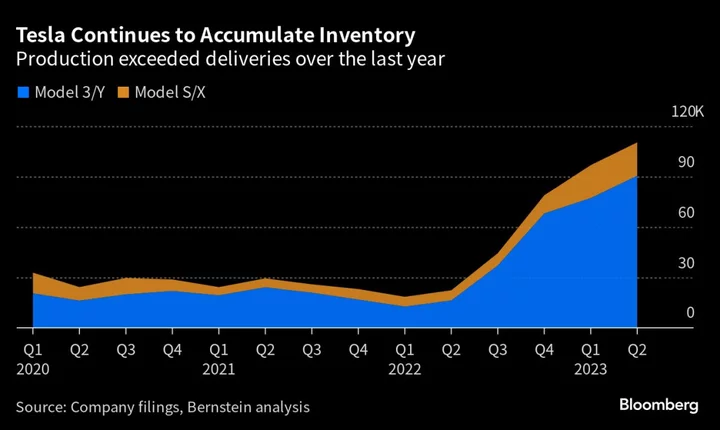There was a lot to like in Tesla Inc.’s latest quarterly numbers.
The carmaker delivered roughly 18,000 more vehicles than analysts were expecting, and over 43,000 more than in any previous quarter. It produced more than 920,500 cars in the first half, well on track to meet its forecast for around 1.8 million this year.
Now, the attention turns to the extent of the toll that prioritizing growth over profitability took on margins in the second quarter. And not only that, what is Elon Musk’s plan to squeeze more sales out of the two models Tesla has relied on for 97% of its deliveries this year?
For as successful as the Model Y SUV and Model 3 sedan have been — they were the No. 1 and No. 2 highest-volume luxury vehicles globally last year, according to Bernstein — they launched three and six years ago. Tesla has cut their prices substantially, qualified for up to $7,500 federal tax credits in the US, and offered perks like months of free fast-charging to try to clear Model 3 inventory cars as last quarter came to a close.
And yet, Tesla still made about 13,300 more of these vehicles than it sold in the last three months. It’s produced about 74,300 more than it’s delivered over the last year.
“We believe Tesla will need to further reduce pricing and/or increase promotional activity this year and/or next year, incrementally pressuring margins,” Bernstein analyst Toni Sacconaghi wrote in a report this week.
The cavalry isn’t coming for Tesla’s two workhorses anytime soon: Its fortunes largely rest on how much additional volume they can manage.
Yes, Tesla has said it will start making the Cybertruck later this year, but Musk has repeatedly cautioned that production will start slowly. During the company’s annual meeting in May, he said it’s going to be difficult to make the pickup affordable because it will require new manufacturing methods.
“In the grand scheme of things, relative to the production rate of all the other cars we make, it will be small,” he said.
Until Tesla can ship lower-cost next-generation models in volume — Bernstein doesn’t expect this before 2025 — Tesla will need to find a way to keep getting more out of its two breadwinners. It’s been working on refreshed versions of the Model 3 and Y, codenamed Project Highland and Project Juniper, but it’s unclear when they’ll be ready, and whether Tesla will need to schedule downtime at its plants in California, China, Germany and Texas to change over to new tooling and rework assembly lines.
Tesla’s minimalist approach to its lineup served the company well during the pandemic — having only a few models to feed with parts helped the company to navigate unprecedented supply chain disruptions. Musk now appears to be testing the limits of this strategy, and will need some combination of price cuts and product rejuvenation to meet the market’s expectations for even more growth.

